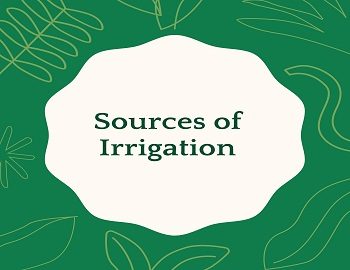Table of Contents
What is Irrigation?
Water is an important input for successful agriculture. Water may be available to crops in the natural course by rainfall or it may be supplied to the agricultural fields artificially by human efforts. The process of supplying water to crops by artificial means such as canals, wells, tube-wells, tanks, etc. from the sources of water such as rivers, ponds, or underground water is called irrigation.
In India, irrigation is important due to the following reasons:
- Uneven distribution of rainfall– There is a wide variation in rainfall from region to region. Certain places receive adequate rainfall while in many regions rainfall is sparse, which is overcome by irrigation.
- Variable rainfall– In India, rainfall is usually erratic and the monsoon lasts only for about 3 to 4 months. Therefore, it is necessary to provide water through other means for better agricultural yields.
- Cultivation of Certain Crops– Almost every possible type of crop grows in India. But certain crops such as rice, sugarcane, etc. require an adequate and regular supply of water. Irrigation only can solve this problem.
- Hot Climate– Being a tropical country, the temperature is high in most parts and the rate of evaporation is high. So an artificial supply of water is necessary for the field.
- Occupation– Agriculture is the main occupation of the majority of people, therefore, proper irrigation would provide better employment opportunities.
- Green Revolution Programme– is introduced in many parts of our country where fertilizers are used in large quantities. But the use of fertilizers can be effective if irrigation water is available regularly.
Sources of Irrigation:
Different sources of irrigation are used depending upon the topography, soils, rainfall, availability of surface or groundwater, nature of rivers (whether perennial or non-perennial), requirements of crops, etc.
The main sources of irrigation used in different parts of the country are-
- Wells and Tube Well Irrigation.
- Canal Irrigation.
- Tank Irrigation.
Wells and Tube Well Irrigation:
Wells and tube wells are presently the most important means of irrigation in India and account for about 63.63% (2011-12) of the total irrigated area of the country.
These are popular in the alluvial plains where the ground is soft and easy to dig. The two types of wells are surface and subsurface wells and tube wells.
The surface and subsurface wells are easy to dig and maintain where groundwater is available. They may be either lined with bricks, stones, and masonry or may be unlined wells. Water may be drawn up from these manually with a rope and bucket by using a Rahat worked on by draught animals like bullocks or with a Persian Wheel. It may also be drawn out by using pumps powered by diesel or electricity.
Tube wells have been introduced in the past few decades where there is sufficient groundwater supply and the soil is fertile to facilitate boring of tube well as into the earth and tapping groundwater. The water is pulled up a deep bore made in the ground, inserted with the help of electrically operated pumps. Tube wells are more reliable than wells because the borehole taps the water from an aquifer (a water-bearing rock). Tube wells are used extensively in the northern plains of Uttar Pradesh, Bihar, Punjab and Harayana, Gujarat, Rajasthan, Maharashtra and Andhra Pradesh, and West Bengal.
Advantages of Wells and Tube well Irrigation:
- Well is the simplest and cheapest source of irrigation and the poor Indian farmer can easily afford it.
- A well is an independent source of irrigation and can be used as and when the necessity arises. Canal irrigation, on the other hand, is controlled by other agencies and cannot be used at will.
- Excessive irrigation by canal leads to the problem of reh which is not the case with well irrigation.
- There is a limit to the extent of canal irrigation beyond the tail end of the canal while a well can be dug at any convenient place.
- Several chemicals such as nitrate, chloride, sulfate, etc. are generally found mixed in well water. They add to the fertility of soil when they reach the agricultural field along with well water.
- The farmer has to pay regularly for canal irrigation which is not the case with well irrigation.
- It stores monsoon water which otherwise would run waste.
Disadvantages of Wells and Tube well Irrigation:
- Only limited areas can be irrigated. Normally, a well can irrigate 1 to 8 hectares of land.
- The well may dry up and may be rendered useless for irrigation if excessive water is taken out of it.
- In the event of a drought, the groundwater level falls and enough water is not available in the well when it is needed the most.
- Tubewells can draw a lot of groundwater from its neighboring areas and make the ground dry and unfit for agriculture.
- Irrigation through well is time taken and causes strain to the draft or draught animals.
- Well, and tube well irrigation is not possible in areas of brackish groundwater.
Canal Irrigation:
Canals are the second most important means of irrigation and account for about 26.19% (2011-12) of the total irrigated area of India. It is well developed in Punjab, Harayana, Uttar Pradesh, and the rest of the Indo-Gangetic plain, and in the deltas of the peninsular rivers Mahanadi, the Godavari, Krishna, and Kaveri. River water is diverted into canals that have been dug with great ease in the northern plains because the ground is soft to dig and the land has a gentle slope. Moreover, the heavy expense incurred in the construction of canals was worthwhile because the fertile alluvial soils provided rich agricultural harvests after they were supplied with water in a regulated manner. The construction of canals in peninsular India on the same scale as the north was considered too expensive because of the rocky terrain. The canal system is better developed in the coastal plains and deltaic regions. There are different types of canals, namely, perennial and inundation or flood canals and storage canals.
Perennial Canals:
Perennial canals draw their water from the perennial rivers or from reservoirs behind dams.
Inundation or flood canals:
Inundation Canals are spill channels. The floodwaters are diverted into these canals. River Sutlej has many such seasonal canals.
Storage canals:
In peninsular India, storage canals facilitate storage of water for use in the dry season.
Advantages of Canal Irrigation:
- Most of the canals provide perennial irrigation. This saves the crops from drought conditions and helps in increasing farm production.
- Canals are constructed by the government and provide water to the farmers at extremely nominal rates.
- Canals have restored the fertility of many regions which were barren and have greatly contributed to India’s food security.
- Canals are like small rivers and streams and carry a lot of silt which restores soil fertility.
Disadvantages of Canal Irrigation:
- At some places, canal water seeps into the adjoining fields and causes water-logging.
- Excess of water raises the water table and deposits of salts take place on the ground which is called salinization, thus making the soil infertile.
- During heavy rainfall, canals overflow or break the banks causing floods.
- Canals are effective only in the plain areas.
- Excessive siltation decreases the efficiency of canals.
- The marshy areas near the canals act as breeding grounds of mosquitoes which result in widespread malaria.
Tank Irrigation:
It is common in peninsular India and in the eastern states. It accounts for 3.48% (2011-12) of the total irrigated area in the country. Mud/earthen and masonry walls are built across a depression or a valley to store water in tanks as the land is too hard and rocky to dig wells or canals.
Tank irrigation is more common in the peninsular plateau region due to the following factors-
- Canals are difficult to build and wells cannot be dug due to hard terrain.
- There is little seepage of water due to the underlying hard rocks and water is retained for long times.
- Many rivers dry up during the summers and therefore, cannot supply water through canals.
- Rivers get plenty of water during the rainy season which can be impounded by making dams and bunds.
- The scattered nature of population and agricultural fields favors tank irrigation.
Advantages of Tank Irrigation:
- It allows monsoon waters to be stored and used in dry periods.
- It raises the underground water level.
- Tank irrigation is cheaper as the rainwater is collected in natural depressions.
- Not only irrigation but also in many villages tanks form the source of water for domestic purposes.
- It stores monsoon water which otherwise would run waste.
Disadvantages of Tank Irrigation:
- It has no such use in drought periods as tanks are filled with rainwater which is scarce during the drought period.
- The tanks occupy larger area which could be used for cultivation.
- Tanks are usually shallow. Due to the high temperatures, water is lost through evaporation.
- Due to the stagnation of water, siltation takes place and the water used for irrigation is mineral-free and is not good for cultivation.
What is Water Logging?
In order to provide congenial moisture to the growing crops, farmers usually apply heavy irrigation to their farmland. Also, in order to leach down the salt deeper into the soil, the farmers provide more irrigation water. However, due to inadequate drainage and poor quality irrigation water, there is an accumulation of water underground and gradually it forms a continuous column with the water table. We call these soils as waterlogged soils that affect crop growth due to the inhibition of exchanges of gases. The pore-spaces between the soil particles get fully drenched with water through the roots.
Water logging is most often associated with salinity because the water used for irrigation contains salts and the soils get badly degraded due to erroneous irrigation practices.









Comments (No)